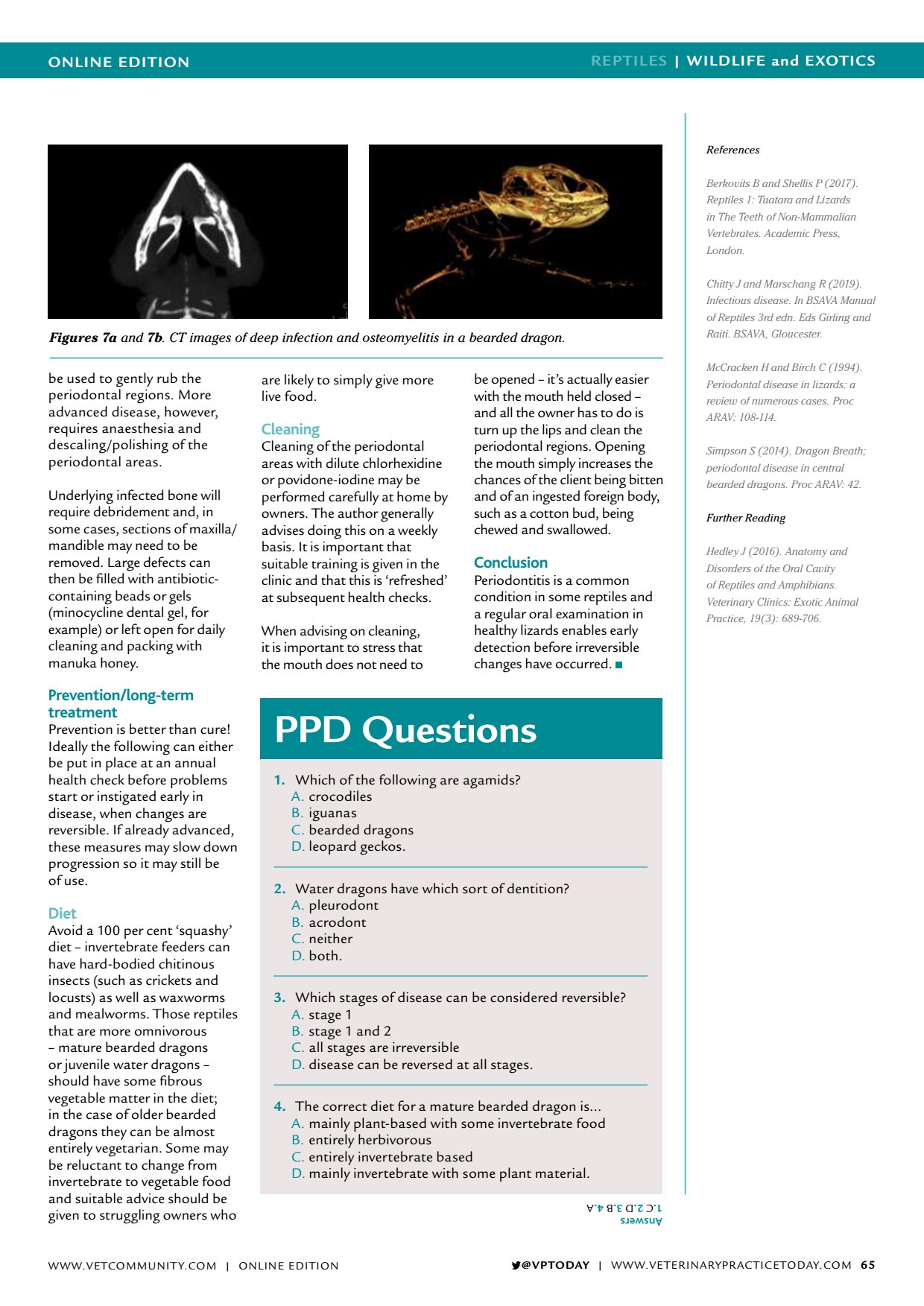Questions Preventionlong-term treatment
ONLINE EDITION REPTILES | WILDLIFE and EXOTICS VPTODAY | WWW.VETERINARYPRACTICETODAY.COM 65 References Berkovits B and Shellis P (2017). Reptiles 1: Tuatara and Lizards in The Teeth of Non-Mammalian Vertebrates. Academic Press, London. Chitty J and Marschang R (2019). Infectious disease. In BSAVA Manual of Reptiles 3rd edn. Eds Girling and Raiti. BSAVA, Gloucester. McCracken H and Birch C (1994). Periodontal disease in lizards: a review of numerous cases. Proc ARAV: 108-114. Simpson S (2014). Dragon Breath; periodontal disease in central bearded dragons. Proc ARAV: 42. Further Reading Hedley J (2016). Anatomy and Disorders of the Oral Cavity of Reptiles and Amphibians. Veterinary Clinics: Exotic Animal Practice, 19(3): 689-706. PPD Questions 1. Which of the following are agamids? A. crocodiles B. iguanas C. bearded dragons D. leopard geckos. 2. Water dragons have which sort of dentition? A. pleurodont B. acrodont C. neither D. both. 3. Which stages of disease can be considered reversible? A. stage 1 B. stage 1 and 2 C. all stages are irreversible D. disease can be reversed at all stages. 4. The correct diet for a mature bearded dragon is A. mainly plant-based with some invertebrate food B. entirely herbivorous C. entirely invertebrate based D. mainly invertebrate with some plant material. Answers 1. C 2. D 3. B 4. A Figures 7a and 7b . CT images of deep infection and osteomyelitis in a bearded dragon. be used to gently rub the periodontal regions. More advanced disease, however, requires anaesthesia and descaling/polishing of the periodontal areas. Underlying infected bone will require debridement and, in some cases, sections of maxilla/ mandible may need to be removed. Large defects can then be filled with antibiotic- containing beads or gels (minocycline dental gel, for example) or left open for daily cleaning and packing with manuka honey. Prevention/long-term treatment Prevention is better than cure! Ideally the following can either be put in place at an annual health check before problems start or instigated early in disease, when changes are reversible. If already advanced, these measures may slow down progression so it may still be of use. Diet Avoid a 100 per cent squashy diet invertebrate feeders can have hard-bodied chitinous insects (such as crickets and locusts) as well as waxworms and mealworms. Those reptiles that are more omnivorous mature bearded dragons or juvenile water dragons should have some fibrous vegetable matter in the diet; in the case of older bearded dragons they can be almost entirely vegetarian. Some may be reluctant to change from invertebrate to vegetable food and suitable advice should be given to struggling owners who are likely to simply give more live food. Cleaning Cleaning of the periodontal areas with dilute chlorhexidine or povidone-iodine may be performed carefully at home by owners. The author generally advises doing this on a weekly basis. It is important that suitable training is given in the clinic and that this is refreshed at subsequent health checks. When advising on cleaning, it is important to stress that the mouth does not need to be opened its actually easier with the mouth held closed and all the owner has to do is turn up the lips and clean the periodontal regions. Opening the mouth simply increases the chances of the client being bitten and of an ingested foreign body, such as a cotton bud, being chewed and swallowed. Conclusion Periodontitis is a common condition in some reptiles and a regular oral examination in healthy lizards enables early detection before irreversible changes have occurred. WWW.VETCOMMUNIT Y.COM | ONLINE EDITION
